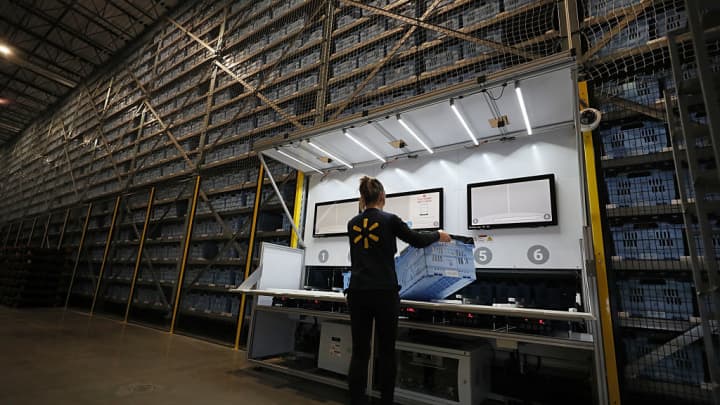Where Walmart, Amazon and Target are spending billions in a slowing economy

A Walmart employee loads up a robotic warehouse tool with an empty cart to be filled with a customer’s online order at a Walmart micro-fulfillment center in Salem, NH. on Jan. 8, 2020.
Boston Globe | Boston Globe | Getty Images
When the economy slows down, the classic response for consumer businesses is to cut back: slow hiring, maybe lay off workers, slash marketing, or even slow the pace of technology investment, delaying projects until after business has picked up again.
But that’s not at all what America’s troubled retail sector is doing this year.
With the S&P Retail Index down nearly 30% this year, most of the industry is boosting investment in capital spending by double digits, including industry leaders Walmart and Amazon.com. Among the top tier, only struggling clothier Gap and home-improvement chain Lowe’s are cutting back significantly. At electronics retailer Best Buy, first-half profits fell by more than half – but investment rose 37 percent.
“There is definitely concern and awareness about costs, but there is a prioritization happening,” said Thomas O’Connor, vice president of supply chain-consumer retail research at consulting firm Gartner. “A lesson has been taken from the aftermath of the financial crisis,” O’Connor said.
That lesson? Investments made by big-spending leaders like Walmart, Amazon and Home Depot are likely to result in taking customers from weaker rivals next year, when consumer discretionary cash flow is forecast to rebound from a year-long 2022 drought and revive shopping after spending on goods actually shrank early this year.
After the 2007-2009 downturn, 60 companies Gartner classified as “efficient growth companies” that invested through the crisis saw earnings double between 2009 and 2015, while other companies’ profits barely changed, according to a 2019 report on 1,200 U.S. and European firms.
Companies have taken that data to heart, with a recent Gartner survey of finance executives across industries showing that investments in technology and workforce development are the last expenses companies plan to cut as the economy struggles to keep recent inflation from causing a new recession. Budgets for mergers, environmental sustainability plans and even product innovation are taking a back seat, the Gartner data shows.
Read the full article on CNBC.